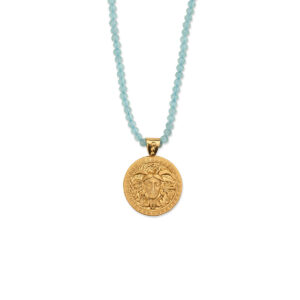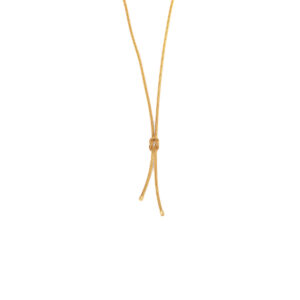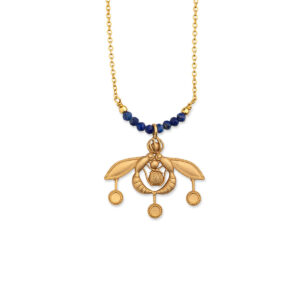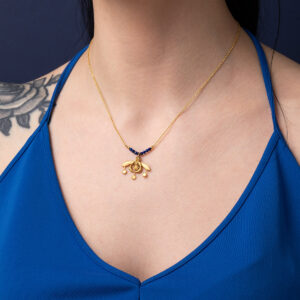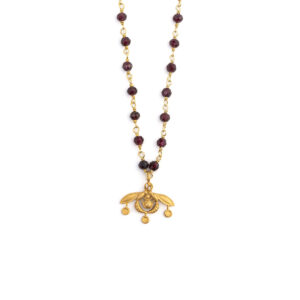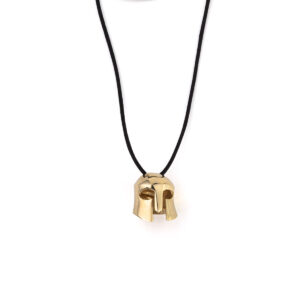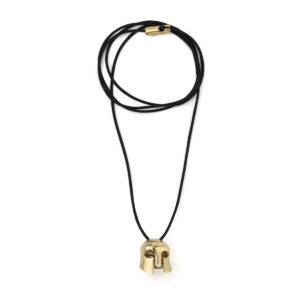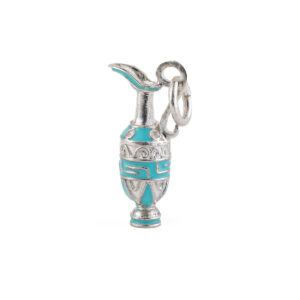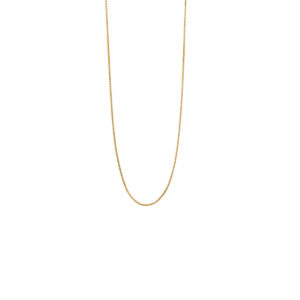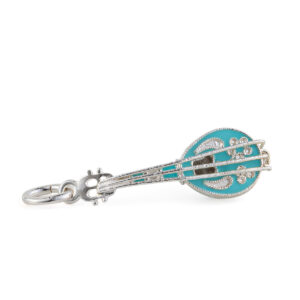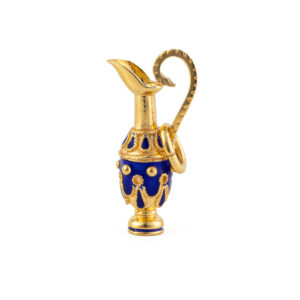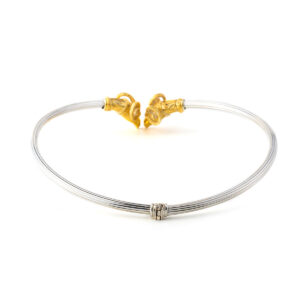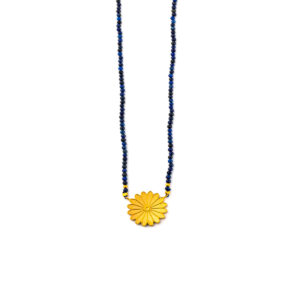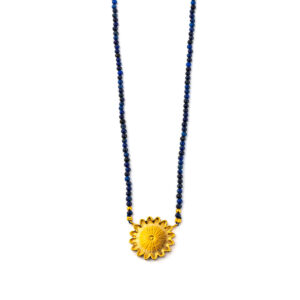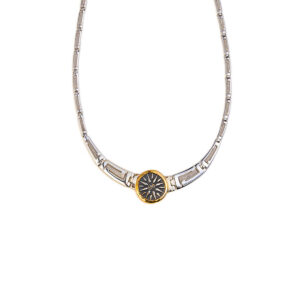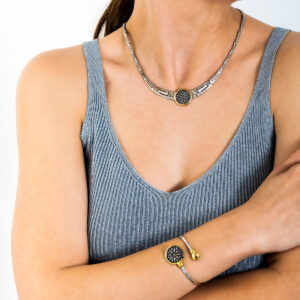Stone string necklace with Medusa pendant
Made of 925° sterling silver.
Length 40cm with extra chain with loops to adjust length up to 5cm.
Handmade item.
Explore Coins Collection
Handmade semi precious stone string necklace with sterling silver plated coin pendant with embossed Medusa. In greek mythology, Medusa, also called Gorgo, was one of three Gorgons. Medusa is described as a human female with living venomous snakes in place of hair. Those who gazed into her eyes would turn to stone. In the end of the necklace there is chain with links to adjust the length.
Knot Necklace Gold Plated
Made of sterling silver 925° and gold plated.
Handmade in Greece.
Explore Heritage Collection
Rosary Necklace with Stones and Cretan Bee
This necklace is made of 925 sterling silver and gold plated with lapis lazuli stones and a Minoan Bee Pendant.
Handmade in Greece.
Explore Heritage Collection
History
The Malia honeybee pendant was discovered at Chryssolakkos, of the Minoan Palace of Malia on the island of Crete, and is thought to date to c.1800 BC. The named Chryssolakkos means the “pit of gold” because of the precious objects that the farmers used to find there. The Minoan Palace is situated 3 km east of Malia town and is the third most significant known Minoan Palace after Knossos and Phaistos. This pendant is in the shape of two bees, or wasps, storing away a drop of honey in a comb and is one of the most famous exhibits in the Herakleion Museum.
Rosary Necklace with Sterling Silver Cretan Bee Pendant
This necklace is made of 925 sterling silver and gold plated with garnet stones and a Minoan Bee Pendant.
Handmade in Greece.
Explore Heritage Collection
History
The Malia honeybee pendant was discovered at Chryssolakkos, of the Minoan Palace of Malia on the island of Crete, and is thought to date to c.1800 BC. The named Chryssolakkos means the “pit of gold” because of the precious objects that the farmers used to find there. The Minoan Palace is situated 3 km east of Malia town and is the third most significant known Minoan Palace after Knossos and Phaistos. This pendant is in the shape of two bees, or wasps, storing away a drop of honey in a comb and is one of the most famous exhibits in the Herakleion Museum.
Leonidas Helmet Necklace – Gold Plated 925 Sterling Silver
140,00€ – 152,00€Necklace with Helmet inspired by the Spartan Leonidas.
Made in 925°sterling silver
Handmade item.
Amphora Pendant Necklace with Meander – 925 Sterling Silver
Ancient Greek Amphora Pendant with enamel and Meander design.
Design inspired by the ancient Greek history.
Made of sterling silver.
Handmade item.
The chain shown is included.
Amphora is a Greco – Roman word developed in ancient Greek during the Bronze Age. An amphora is a type of container of a characteristic shape and size. Amphorae were used for the transport and storage of various products, both liquid and dry, but mostly for wine. They are most often ceramic. the amphorae used in Ancient Greek vase painting. (source wikipedia)
Meander or Meandros design, one of the most historic symbols of the Greek World, also called Greek Key and symbolizes long life and eternity. The pattern with Meander was used in antiquity to decorate the frieze of temples.
Amphora Pendant Necklace with Meander – 925 Sterling Silver and Gold Plated
Ancient Greek Amphora Pendant with enamel and Meander design.
Design inspired by the ancient Greek history.
Made of sterling silver and gold plated.
Handmade item.
The chain shown is included.
Amphora is a Greco – Roman word developed in ancient Greek during the Bronze Age. An amphora is a type of container of a characteristic shape and size. Amphorae were used for the transport and storage of various products, both liquid and dry, but mostly for wine. They are most often ceramic. the amphorae used in Ancient Greek vase painting. (source wikipedia)
Meander or Meandros design, one of the most historic symbols of the Greek World, also called Greek Key and symbolizes long life and eternity. The pattern with Meander was used in antiquity to decorate the frieze of temples.
Bouzouki Pendant Necklace – 925 Sterling Silver
Greek Bouzouki Charm with enamel. The pendant is decorated with rosette motifs.
Made of sterling silver.
Handmade in Greece.
The chain shown is included.
Design inspired by the Greek tradition.
Explore Heritage Collection
History
The Greek bouzouki is a plucked musical instrument of the lute family, called the thabouras or tambouras family. The tambouras existed in ancient Greece as the pandura, and can be found in various sizes and shapes. The bouzouki and the baglamas are the direct descendants. The bouzouki arrived in Greece following the 1919–1922 war in Asia Minor and the subsequent population exchange between Greece and Turkey. The early bouzoukia mostly had three courses. At the end of the 1950s, four-course (tetrachordo) bouzoukia started to gain popularity. The four-course bouzouki was made popular by Manolis Chiotis. Manolis Chiotis was a Greek rebetiko and laiko composer, singer, and bouzouki player. He is considered one of the greatest bouzouki soloists of all time.
Greek Bouzouki Pendant Necklace
Greek Bouzouki Charm pendant decorated with rosette motifs.
Made of sterling silver and gold plated.
Handmade in Greece.
The chain shown is included.
Design inspired by the Greek tradition.
Explore Heritage Collection
History
The Greek bouzouki is a plucked musical instrument of the lute family, called the thabouras or tambouras family. The tambouras existed in ancient Greece as the pandura, and can be found in various sizes and shapes. The bouzouki and the baglamas are the direct descendants. The bouzouki arrived in Greece following the 1919–1922 war in Asia Minor and the subsequent population exchange between Greece and Turkey. The early bouzoukia mostly had three courses. At the end of the 1950s, four-course (tetrachordo) bouzoukia started to gain popularity. The four-course bouzouki was made popular by Manolis Chiotis. Manolis Chiotis was a Greek rebetiko and laiko composer, singer, and bouzouki player. He is considered one of the greatest bouzouki soloists of all time.
Greek Tsarouhi Pendant Necklace with Enamel – 925 Sterling Silver and Gold Plated
Have you witnessed the changing of the guards in Syntagma square? This is the most traditional shoe of Greece (tsarouhi). The pendant is decorated with green enamel and rosette motif.
Made of sterling silver and gold plated.
Handmade item.
Design inspired by the Greek tradition
The chain shown is included.
The rosette (rose) is a timeless jewel, symbol and amulet. The origin of the term is the Greek word for rose – rodon (ρόδον). Its use began in the Mycenaean era and continues as far as the 2nd millennia BC. The Mycenaean Rosette is a motif that was widespread throughout Mesopotamia, Egypt, Greece and other ancient civilizations. Rosette or Rodax was probably the most popular and favorite decorative element in Mycenaean era, classical antiquity and Byzantine times.
Amphora Pendant Necklace with Enamel – 925 Sterling Silver and Gold Plated
Ancient Greek Amphora Pendant with enamel.
Design inspired by the ancient Greek history.
Made of sterling silver and gold plated.
Handmade item
Amphora is a Greco – Roman word developed in ancient Greek during the Bronze Age. An amphora is a type of container of a characteristic shape and size. Amphorae were used for the transport and storage of various products, both liquid and dry, but mostly for wine. They are most often ceramic. the amphorae used in Ancient Greek vase painting. (source wikipedia)
Lion Head Necklace – 925 Sterling Silver
This sterling silver necklace is inspired by the lion motif, a symbol of strength, courage and leadership.
Lions have been widely used in art to provide a sense of majesty and awe. Lions were bold creatures and many ancient cities would have an abundance of lion sculptures to show strength. There are lions at the entrances of cities and sacred sites from Mesopotamian cultures; notable examples include the Lion Gate of ancient Mycenae in Greece that has two lionesses flanking a column that represents a deity. The Lion Gate was the main entrance of the Bronze Age citadel of Mycenae. It was erected during the 13th century BC, around 1250 BC in the northwest side of the acropolis.
Made of 925⁰ sterling silver.
Available in gold plated.
Handmade item.
Rams Head Necklace – Sterling Silver and Gold Plated
This necklace features a Rams Head design inspired by actual ancient Greek history. In ancient Greek mythology, the ram was symbol of virility and fertility, power and leadership. The ram’s head also symbolizes Aries the first sign of the zodiac.
Made of 925⁰ sterling silver and gold plated.
Handmade item.
Rosette Necklace with stones – 925 Sterling Silver
The necklace is decorated with a rosette flower.
Made in 925⁰ sterling silver and gold plated.
Handmade item.
Design inspired by the incredible beauty of byzantine and greek art.
Explore Heritage Collection
Mycenaean Rosette (Rodakas)
The rosette (known as “rodakas” in Greek) is a motif that was prevalent across Mesopotamia, Egypt, and other ancient civilizations. It also appears frequently in Mycenaean Greece, especially in jewelry, as well as in architecture and pottery dating back to around 1500 BC.
Mycenaean rosettes typically feature 6, 8, or 12 petals. Made from gold, these intricate designs were commonly used to adorn clothing for both men and women, sewn directly into the fabric. They also appeared in belts, necklaces, and were occasionally used as single decorative elements in earrings and rings.
The rosette motif is believed to symbolize a wild rose, a flower frequently depicted in frescoes from the era. Its presence in garlands for celebrations, its use in rituals as offerings placed in women’s hands, and references in the Linear B tablets of Knossos to a “month of the roses” all suggest that the rosette carried a symbolic meaning. These factors point to the idea that the rosette motif held religious and cultural significance in Mycenaean society, possibly linked to rites of renewal or celebration.
Vergina Sun Necklace Sterling Silver and Gold
328,00€Necklace inspired by the ancient Vergina sun symbol.
Made in 925°sterling silver and 14K gold.
Handmade in Greece.
History
The Vergina Sun also known as the “Star of Vergina” is a rayed solar symbol appearing in ancient Greek art. The Vergina Sun proper has sixteen triangular rays. The name “Vergina Sun” became widely used after the archaeological excavations in and around the small town of Vergina, in northern Greece, during the late 1970s.
Explore Heritage Collection

